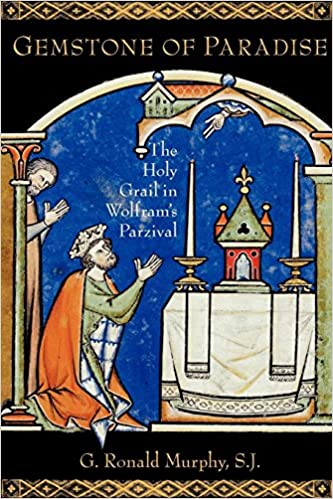Wolfram Eschenbach’s notioned that the Grail is a stone. Even though his Parzival was one of the most popular and spiritually challenging tales of medieval Germania—as Albrecht Classen notes,
“this courtly romance might be one of the most intriguing literary works of its time in terms of intellectual and spiritual epistemology”
—still Wolfram’s view on the nature of the Grail as a stone is nowadays treated by critics with mystified respect and then allowed, as if inconvenient, to disappear from discussion and gradually, as it were, slip from sight. This, while his Parzival paradoxically remains acknowledged as the greatest medieval telling of the story of the Grail. Roger Loomis summarizes this opinion:
In short there breathes throughout the poem a spirit bold, realistic, generous, tender, and magnanimous. For most moderns who can either read the original German or can find a satisfactory translation …Parzival is the most satisfying medieval treatment of the legend of the Grail. ( The Grail, p. 222 )
Arthurian literature
In the scholarly quest for the identity of the Holy Grail in Arthurian literature, Wolfram’s version, namely, that it is a mysterious stone carried by Repanse de Schoye, the beautiful lady whose name in Wolfram’s French signifies overflowing or spreading joy, is a stumbling block. Dutifully examined along with the other variants based on the dishor cup from Chretien’s version, and with great respect for the spirituality of Wolfram’s Parzival, Wolfram’s stone Grail is often allowed by scholars of Grail legend to disappear quietly into the waste forest of mystifying and unintelligible metaphor.

Jesse Weston found that when she removed all accretions, the root of the Grail was older than Celtic and Christian conceptions and was to be found in vegetation ritual!
Jessie L. Weston, From Ritual to Romance (Princeton: Princeton University Press, [1920] 1993), esp. pp. 71–2, 162. Weston is aware of Burdoch’s liturgical view but rejects the thesis of Byzantine ritual’s influence on the Grail ceremony on the curious ground that the ritual “spear” used in cutting the bread is not a full-sized spear, and on the basis of her hypothesis that the earlier vegetation mysteries from Greece were what contributed to the mysterious nature of the Eucharistic rites of Constantinople.
In contradistinction, Wolfram claims that his stone is both the root and branch of all the Grail’s powers.
In his Gemstone of Paradise Ronald Murphy provides a summary review of the numerous characteristics Wolfram gives to his Grail stone in Parzival:
-
-
-
- It is a stone and an object der stein ist ouch genant der gral(469, 28);
daz was ein dinc, daz hiez der gral(235, 23);
the Grail should not be seen as an abstract ideal in Wolfram.
- It is portable but is carried only, with its permission, by a beautiful lady with the significant name Repanse de Schoy (“Overflowing Happiness”), the radiant queen without falsehood; she holds it on an oriental green silken cloth, üf einem gruenen achmardi(235, 20–1).
- It is the bliss of Paradise, both the source and perfection of that bliss; and it is earthly happiness in overflow that she is carrying, “truoc si den wunsch von pardıs, / bede wurzeln underıs. Daz was ein dinc, daz hiez der Gral, / erden wunsches überwal” (235, 21–4).
- When carried in procession, it is preceded by candles and balsamincense: vorem grale komen lieht—die da truogen balsemvaz (236, 1– 11).
- It is placed solemnly before the host, Anfortas, upon a thinly cut, lightweight, blood-red stone tabletop; the tabletop was cut so thin that sunlight shone through it. Sine trüegen einen tiuren stein, / daˆ tages de sunne lieht durch schein . . . ez was ein granat jachant (a blood-red stone), / beide lanc unde breit. / durch die lˆıhte in dünne sneit / swer in zeime tische maz” (233, 17–23). The Grail is thus associated with two colors: the green of silken cloth on which it is borne, and the red of the table on which it is placed. It is conjoined with translucent stone. In accord with the liturgical usage of placing reliquaries containing the Host and relics of the saints on a non consecrated tabletop in order to consecrate it for the celebration of Mass or one of the sacraments, the Grail is placed on the translucent portable stone table.
- The stone Grail is called lapsit exillıs (or possibly lapis exilis, oriaspis, or lapsit exillis, or even exillix and exilix, according to the manuscripts). Wolfram’s Latin name for the Grail was not immediately intelligible to the copyists (as sometimes with his French names) and he may have used this device to suggest the mystery of something both concrete and transcendent and therefore not quite intelligible (469, 7–8).
- The Grail is the stone of the Phoenix, the fabled stone by whose power the Phoenix of classical mythology rises in rebirth from its ashes “von des steines kraft der fenıs verbrinnet, daz er zaschen wirt: / diu asche im aber leben birt” (469, 8–10). The stone, therefore, is the place where the dead body is placed, the place of death and resurrection, and the stone contains the power to turn death into life.
- A white dove shining with brilliant light comes down every Good Friday with a Communion Host and places it on the Grail stone to renew its powers. “Ez ist hiute der karfrıtac, / daz man furwarda warten mac, / ein tub von himel swinget: / uf den stein diu bringet / ein kleine wıze oblat. Uf dem steine si die lat: diu tube ist durchliuhtec blanc … immer alle karfrıtage / bringet se uf den” (470, 1– 10). The resurrective powers of the phoenix stone come from a Communion Host that comes from Heaven brought by the Dove and placed on the bare stone on Good Friday. From the Dove the Grail receives all of its powers to bestow a largesse like that of Paradise. The coat of arms of the knights of the Grail, the templeisen, is the turtledove. Altering the emblem of the Grail knights from dove to turtledove adds the connotation of love.
- Only the baptized can see the Grail. Feirefiz: “ich ensehe niht wan ein achmardı” (810, 7–13). Parzival’s half-brother, Feirefiz, cannot see the Grail until he is baptized. This suggests that the eyes of faith are required to see the presence of the Dove, which is durchliuhtec (his radiance shines through things), and the Communion Host, as well as the Grail itself. Otherwise one sees, as Feirefiz does, only the exterior covering, the “green achmardi” of the stone.
- The neutral angels were sent to it when the fighting began between Lucifer and the Trinity di newederhalp gestuonden, / do strıten beguon den Lucifer unt Trinitas (471, 15–7). Like Parzival, these angels are a mythic exemplification of those who do not commit themselves to feeling any concern to speak up—for God (or for Lucifer). Though the possible salvation of these angels is later retracted, Wolfram’s pedagogic use of their lack of commitment and lack of overflow of feeling is not. They are a cautionary tale for the early Parzival. This would imply that one of the mythic purposes of the Grail, and the suffering around it, is to arouse feelings of compassion and loyalty among the indifferent.
- The Grail is the source of the water that overflows into the baptismal font, and also provides the priest. “Der toufnapf wart geneiget / ein wenec geinme gral. / vol wazzers an dem male / wart er, ze warm noch ze kalt. / da stuont ein grawer priester alt” (817, 4–7). The baptismal font is a ruby, red as the table stone in the Grail procession, on a green jasper base—the two gem colors associated with the Grail; water flowing from the Grail into the ruby font would suddenly appear blood-red (816, 20–1). Many authors have noted the allusion to the blood and water that flowed from the wound of the lance in the side of the crucified Christ.
- The country in which the Grail can be found is Terre de Salvaesche, the Land of Salvation.
- The Grail is wide enough to have writing on it, and the writing gives the names of those who are called to be keepers of the Grail. This is a characteristic of many of the reliquary-style, or box-style, altar stones.
- The Grail is defended militarily by an order of knights whose insignia is, paradoxically, the turtledove.
- The Grail has the power to keep the sinful and wounded alive (Anfortas) but does not keep them beautiful.
- The Grail can be found in the stars by the nonbaptized (Flegetanıs), and Christian and non-Christian can be called to its banquet (Parzival and Feirefiz) in the Land of Salvation.
- It is a stone and an object der stein ist ouch genant der gral(469, 28);
-
-
src. Gemstone of Paradise. SJ G. Ronald Murphy
Delve deeper with this excellent read: Gemstone of Paradise




